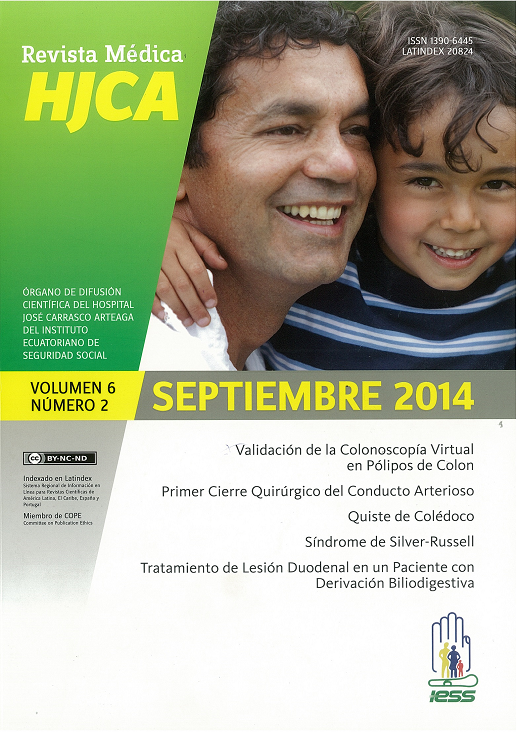Trombolisis Intravenosa una Alternativa Terapéutica para los Pacientes con Ataque Cerebro Vascular Isquémico Reporte de Casos
Palabras clave:
INFARTO ENCEFÁLICO, ATAQUE ISQUÉMICO TRANSITORIO, TROMBOSIS, TERAPIA TROMBOLÍTICA, FIBRINOLÍTICOS, ACTIVADORES PLASMINOGÉNICOS, BRAININFARCTION, TRANSIENT ISCHEMIC ATTACK, THROMBOSIS, THROMBOLYTICTHERAPY, FIBRINOLYTIC, PLASMINOGEN ACTIVATORSResumen
INTRODUCCIÓN: La Enfermedad Cerebro Vascular constituye a nivel mundial una patología de fundamental importancia debido a su frecuencia y sus consecuencias. La trombolisis desde su nacimiento se ha constituido como la herramienta fundamental de tratamiento, sin embargo esta se realiza únicamente en casos seleccionados por lo que es prioritario el conocimiento de estos parámetros, la pronta atención y proactividad de los servicios médicos.
CASO CLÍNICO 1: Mujer de 26 años de edad quien acudió con evolución de 1 hora 40 minutos con cefalea intensa, vómito, dificultad para articular el lenguaje y hemiparesia izquierda. Al examen neurológico reportó escala de NIHSS de 16. Evolución: una tomografía y resonancia al ingreso demostraron datos de isquemia cerebral. A las 2 horas y 30 minutos de inicio del cuadro clínico se trató con trombolisis intravenosa con RTPA. La paciente no presentó complicaciones inherentes al tratamiento, la evolución en la escala de NIHSS fue a las 6 horas de 7 puntos, a las 12 horas de 4 puntos y a las 24 horas de 2 puntos. El diagnóstico final fue déficit de proteína S, se prescribió anticoagulante. Se ha realizado el seguimiento clínico por 1 año 2 meses, sin presentar complicaciones, con recuperación funcional total.
CASO CLÍNICO 2: Mujer de 76 años con 2 horas de evolución de afasia y hemiparesia derecha. La escala de NIHSS al ingreso fue de 17. Evolución: Con el diagnóstico de infarto cerebral, a las 3 horas 10 minutos de inicio del cuadro se inició el esquema de RTPA. La paciente no presentó complicaciones inherentes al procedimiento. La evolución en la escala de NIHSS las 6 horas fue de 9 puntos, a las 12 horas de 6 puntos y a las 24 horas de 1 punto. El diagnóstico final fue estenosis de la carótida interna izquierda en un 55%. El seguimiento se realizó a los 2 meses, sin complicaciones y con funcionabilidad total.
CONCLUSIÓN: El tratamiento trombolítico fue adecuadamente prescrito en los casos presentados con ataque cerebro vascular isquémico (infarto cerebral) en las primeras 4.5 horas desde el inicio de los síntomas, lo que conllevó a un mejor pronóstico, menor discapacidad, menores costos económicos para la familia y para el estado. Por lo expuesto, se requieren esfuerzos asociados con la finalidad de brindar a la comunidad esta alternativa terapéutica probadamente eficaz.
ABSTRACT
INTRAVENOUS THROMBOLYSIS AN ALTERNATIVE THERAPY FOR PATIENTS WITH ISCHEMIC CEREBROVASCULAR ATTACK, CASES REPORT
BACKGROUND: Cerebrovascular disease is a critical disease world wide because of its frequency and its consequences. Thrombolysis since its inception has become a key tool of treatment; however this is only done in selected cases making it a priority to know the parameters, the prompt attention and proactive medical services.
CASE REPORT 1: A 26 year-old woman who attended with evolution of 1 hour 40 minutes with severe headache, vomiting, slurred speech and left hemiparesis. At neurological examination reported on the NIHSS scale of 16. Evolution: a CT scan on admission and showed signs of cerebral ischemia. At 2 hours and 30 minutes of symptom onset she was treated with intravenous thrombolysis with RTPA. The patient had no complications in her treatment, changes in the scale of NIHSS was 6 hours at 7 point at 12 hours at 4 points and 24 hours at 2 points. The final diagnosis was Protein “S” deficiency and she was prescribed an anticoagulant. A clinical follow up has been done for 1 year 2 months, without complications, a complete functional recovery.
CASE REPORT 2: A 76 year-old woman with 2 hours of onset of aphasia and right hemiparesis. The scale of NISS on admission was 17. Evolution: With the diagnosis of Stroke at 3hours 10 minutes of symptom onset RTPA scheme began. The patient had no complications inherent in the procedure. The evolution on the NIHSS scale at 6 hours was 9 points, 12 hours at 6 points and 24 hours at 1 point. The final diagnosis was Stenosis of the left internal carotid artery at 55%. Follow-up was performed for 2 months without complications and with full functionality.
CONCLUSIONS: Thrombolytic therapy was properly prescribed for cases presented with ischemic attack, cerebrovascular (stroke) in the first 4.5 hours since the onset of symptoms, which led to a better prognosis, less disability, fewer economic costs to the family and the state. For these reasons, efforts associated with the goal of providing to the community this demonstrably effective therapeutic alternative.

